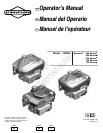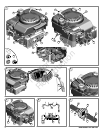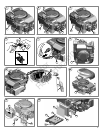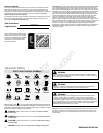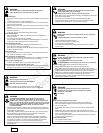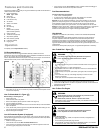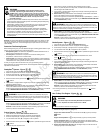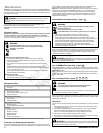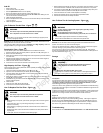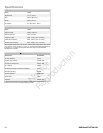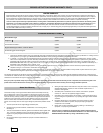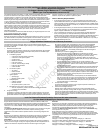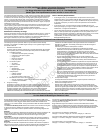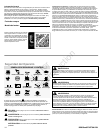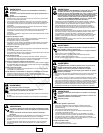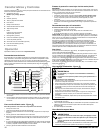
9
en
Add Oil
Place engine level.
Clean the oil fill area of any debris.
See the Specifications section for oil capacity.
1. Remove the dipstick (G) and wipe with ac lean cloth (Figure 13).
2. Pour the oil slowly into the engine oil fill (H). Do not overfill. After adding oil, wait
one minute and then check the oil level.
3. Install and tighten the dipstick.
4. Remove thedipstick andcheck the oillevel. Itshould beat the topof thefull indicator
(J) on the dipstick.
5. Install and tighten the dipstick.
How To Service The Air Filter - Figure
15 16
WARNING
Fuel and its vapors are extremely flammable and explosive.
Fire or explosion can cause severe burns or death.
Never start or run the engine with the air cleaner assembly (if equipped) or the
air filter (if equipped) removed.
NOTICE: Do not use pressurized air or solvents to clean the filter. Pressurized air can
damage the filter and solvents will dissolve the filter.
Two types of air filter systems are shown, a Standard and a Hi gh Capacity. Determine
the type installed on your engine and service as follows.
Standard Air Filter - Figure
15
The air cleaner system uses a foam element that can be washed and reused.
1. Movetheslidelock(A) to the unlock position. Open the cover (B). See Figure 15.
2. Remove the foam element (C).
3. Wash thefoam element inliquid detergent and water. Squeezedry the foamelement
in a clean cloth.
4. Saturate the foam element with clean engine oil. To remove the excess engine oil,
squeeze the foam element in a clean cloth.
5. Install the foam element into the air filter base.
6. Close the cover and move the slide lock to the locked position.
High Capacity Air Filter - Figure
16
The air cleaner systemuses a pleated filterwith an optionalpre-cleaner. The pre-cleaner
can be washed and reused.
1. Loosen the fastener (A) that holds the cover (B, Figure 16).
2. Open the cover and remove the pre-cleaner (C) and the filter (D).
3. To loosen debris, gently tapt he filter on a hard surface. If the filter is excessively
dirty, replace with a new filter.
4. Wash the pre-cleaner in liquid detergent and water. Then allow it to thoroughly air
dry. Do not oil the pre-cleaner.
5. Assemble the dry pre-cleaner to the filter with the lip (E)of the pre -cleaner on the
bottom of the filter pleats.
6. Install the filter.
7. Install the cover tabs (F) into the slots (G).
8. Close the cover and secure with the fastener.
How To Replace The Fuel Filter - Figure
6
WARNING
Fuel and its vapors are extremely flammable and explosive.
Fire or explosion can cause severe burns or death.
Keepfuel awayfromsparks, openflames,pilot lights,heat,and otherignition
sources.
Check fuellines, tank, cap, andfittings frequently forcracks or leaks.
Replace ifnecessary.
Before cleaning or replacing the fuel filter, drain the fuel tank or close the fuel
shut-off valve.
Replacement parts must be the same and installed in the same position as the
original parts.
If fuel spills, wait until it evaporates before starting engine.
1. Before replacing the fuel filter (A, Figure 6), if equipped, drain the fuel tank or close
the fuel shut-off valve. Otherwise, fuel can leak out and cause afire or explosion.
2. Use pliers to squeeze tabs (B) on the clamps (C), then slide the clamps away from
the fuel filter. Twist and pull the fuel lines (D) off of the fuel filter.
3. Check the fuel lines for cracks or leaks. Replace if necessary.
4. Replace the fuel filter with an original equipment replacement filter.
5. Secure the fuel lines with the clamps as shown.
How To Clean The Air Cooling System - Figure
14
Running engines produce heat. Engine parts, especially muffler,
become extremely hot.
Severe thermal burns can occur on contact.
Combustible debris, such as leaves, grass, brush, etc. can catch fire.
WARNING
Allow muffler, engine cylinder and fins to cool before touching.
Remove accumulated debris from muff ler area and cylinder area.
NOTICE: Do not use water to clean the engine. Water could contaminate the fuel
system. Use a brush or dry cloth to clean the engine.
This is an air cooled engine. Dirt or debris can restrict air flow and cause the engine to
overheat, resulting in poor performance and reduced engine life.
Use a brush or dry cloth to remove debris fromthe finger guard (A). Keep linkage,
springs and controls (B) clean. Keep the area around and behind themuffler (C)freeof
any combustible debris (Figure 14).
Storage
WARNING
Fuel and its vapors are extremely flammable and explosive.
Fire or explosion can cause severe burns or death.
When Storing Fuel Or Equipment With Fuel In Tank
Store away from furnaces, stoves, water heaters or other appliances that have
pilot lights or other ignition sources because they can ignite fuel vapors.
Fuel System
Fuel can become stale when stored over 30 days. Stale fuel causes acid and gum
deposits to form in the fuel system or onessential carburetor parts. To keep fuel fresh,
use Briggs & Stratton Advanced Formula Fuel Treatment & Stabilizer, available
wherever Briggs & Stratton genuine service parts are sold.
There is no need to drain gasoline from the engine if a fuel stabilizer is added according
to instructions.Run the enginefor 2 minutesto circulate thestabilizer throughout the fuel
system before storage.
If gasolinein the enginehas not beentreated witha fuel stabilizer, itmust bedrained into
an approved container. Run the engine until it stops from lack of fuel. The use of a fuel
stabilizer in the storage container is recommended to maintain freshness.
Engine Oil
While the engine is still warm, change the engine oil.
NOTICE: Store the engine level (normal operating position). If the engine is tipped for
storage, the fuel tank must be empty and the spark plug side must be up. If the fuel
tank is not empty and if the engine is tipped in any other direction, it maybe difficult to
start due to oil or gasoline contaminating the air filter and/or the spark plug.
Troubleshooting
Need Assistance? Go to BRIGGSandSTRATTON.COM or call 1-800-233-3723 in USA.
Not for
Reproduction



